This book is a priceless treasure of Vietnam, considered one of a kind.
The Golden Book of Generations is an incredibly unique book, unparalleled in Vietnam. With a staggering weight of over 4 kg of pure gold, this golden book has become a focal point for many who wish to admire and learn about its origins.
The Golden Book of Generations has been recognized as a national treasure of Vietnam.
The Unique Book
During the reign of Emperor Minh Mang, there was a book containing special contents. This was the occasion when the emperor composed the poem “Golden Generations” and 10 poems “Branch Generations” in the form of five-word quatrains to assign names to 20 generations of his direct descendants and 10 branches (branch generations) from his 10 brothers.
The Golden Book of Generations measures 23.2 cm in length, 13.7 cm in width, 1.6 cm in thickness, and weighs 4.2 kg, made of pure gold (equivalent to over 100 taels of gold today); its spine is bound with 4 round rings. The book is made in a vertical rectangular format, consisting of 13 pages; the front and back covers are engraved with five-clawed dragons and cloud patterns symbolizing royal power, with 11 internal pages inscribed with literary texts.
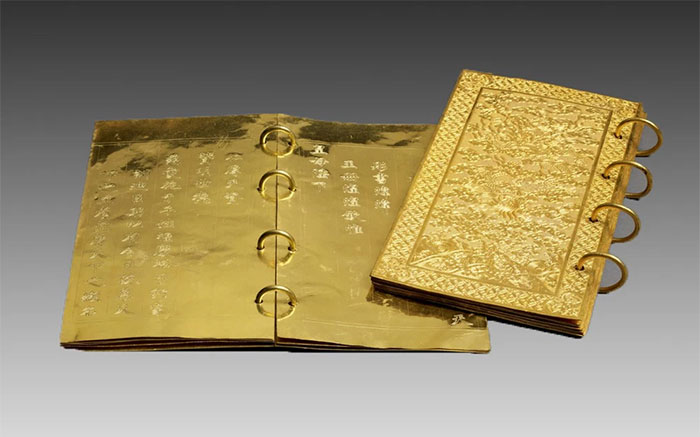
The Golden Book of Generations. (Source: baotanglichsu.vn)
Besides its rare value due to the significant amount of gold used in its creation, the Golden Book of Generations also holds great cultural and historical significance.
The book features the engraved poem “Golden Generations,” which Emperor Minh Mang used to assign names to 11 Nguyen dynasty kings, from Thieu Tri to Bao Dai. In addition to the Golden Book of Generations, the Nguyen dynasty also has many other golden books of great value, currently preserved at the National History Museum.
Most golden books, including those of concubines, empress dowagers, and grand empress dowagers, have an odd number of pages ranging from 5, 7 to 9 pages; only a few of the empresses’ books have an even number of pages, with empresses from the Nguyen Lords having 4 pages, while reigning empresses have 6 pages. The books of the emperors typically consist of 9 pages of gold, being the largest and heaviest.
The Golden Book of Generations is a special case, using 13 pages of gold.
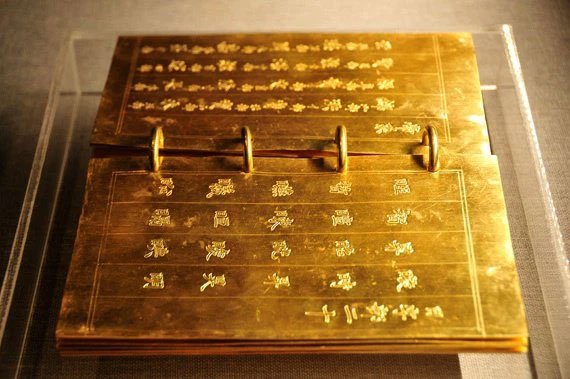
Content of the poem “Golden Generations” engraved on the Golden Book. (Source: Communist Party Newspaper)
According to “Dai Nam Thuc Luc”, in 1816, Emperor Gia Long appointed Crown Prince Nguyen Phuc Dam (the future Emperor Minh Mang) and bestowed upon him a golden book and golden seal. The book consisted of 5 pages of gold, measuring 5 inches 6.6 lines in length, 2 inches 2.4 lines in width, each page being 2 lines thick; the seal was made of gold, with a knob shaped like a seated dragon, measuring 2 inches 4.3 lines square and 3 lines 2 lines thick, inscribed with the four characters “Hoang Thai Tu Bao.”
As for the princes and noblemen, when granted the title of duke or marquis, they used silver books gilded with gold consisting of 5 pages, measuring 5 inches 4 lines in length, 3 inches 2.4 lines in width, each page being 2 lines thick. The seals were also made of silver gilded with gold, measuring 2 inches 3.4 lines square, 2 lines 7 lines thick, with knobs shaped like a dragon without horns, beard, or mane (1)
Naming Descendants for 20 Generations
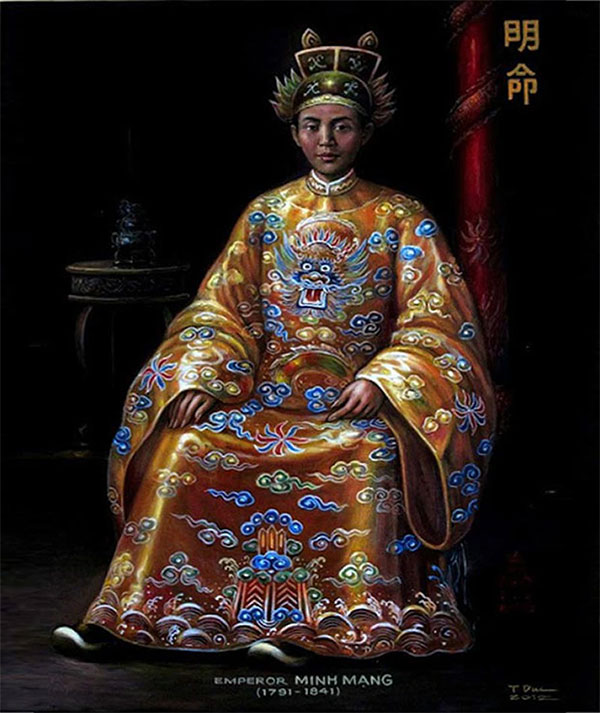
Emperor Minh Mang used the poem “Golden Generations” to name the succeeding generations of descendants. (Source: Ha Tinh Museum)
Emperor Minh Mang (1791 – 1840) was the second emperor of the Nguyen dynasty. He was well-versed in both literature and martial arts, and he was responsible for the construction and establishment of the magnificent capital of Hue, which has now been recognized by UNESCO as a world cultural heritage site.
As a talented and far-sighted king, he was very concerned about the potential for power struggles within the royal family. He early on devised a dual naming system for the royal line (the emperor) and the collateral line (brothers). Minh Mang based this on the Confucian principle of “Rectification of Names,” assigning Duke Dinh Hong Phien (Dinh Nguyen Phien) to create two sets of poems “Golden Generations” and “Branch Generations” to name his descendants and royal brothers.
“Golden Generations” was composed in the form of quatrains, containing 20 characters with auspicious and profound meanings, used as prefixes for the 20 succeeding generations starting from Emperor Minh Mang as follows:
Miên, Hồng, Ưng, Bửu, Vĩnh
Bảo, Quý, Định, Long, Trường
Hiền, Năng, Kham, Kế, Thuật
Thế, Thoại, Quốc, Gia, Xương (2)
In the poem, each character carries a positive meaning, such as Miên representing eternal blessings, and Vĩnh symbolizing everlasting heroic spirit.
Lawyer and writer Pham Khac Hoe once remarked: “By creating this dual naming system, Emperor Minh Mang believed that it would ensure the throne for his direct descendants for at least 20 generations, or approximately 500 years.”
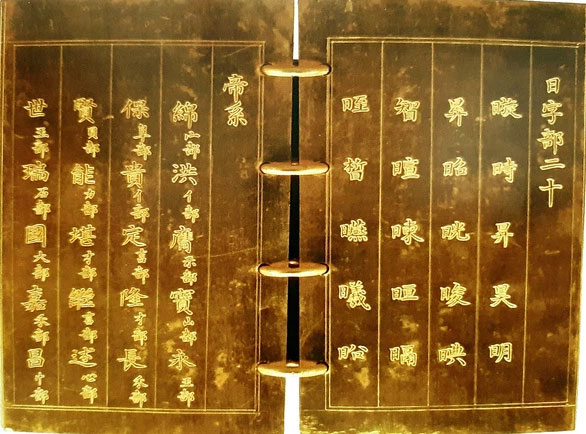
A page from the “Holy Edict Golden Book” containing the poem Golden Generations. (Source: National History Museum of Vietnam).
According to this system, all sons of Emperor Minh Mang must have the prefix Miên, followed by a name given by the royal family; sons of the Miên generation must start their names with Hồng (Hường), followed by a name given by the royal family; sons of the Hồng generation must take the prefix Ưng, followed by a name given by the royal family… and so on until all 20 characters of the Golden Generations poem are used.
With the Golden Generations, Emperor Minh Mang hoped that the throne would be passed down for 20 generations, lasting 500 years. However, it ultimately ended with the character Vĩnh, representing the 5th generation, the 13th emperor of the Nguyen dynasty.
Invaluable National Treasure
In August 1945, Emperor Bao Dai abdicated and transferred all royal treasures to the provisional government. This collection comprised nearly 3,000 items, which were moved to Hanoi. After more than half a century in storage, in 2007, these treasures were transferred to the National History Museum of Vietnam.
At this time, many people learned that among these valuable artifacts were 94 golden books, including a special treasure – the Holy Edict Golden Book, issued by Emperor Minh Mang in 1823.
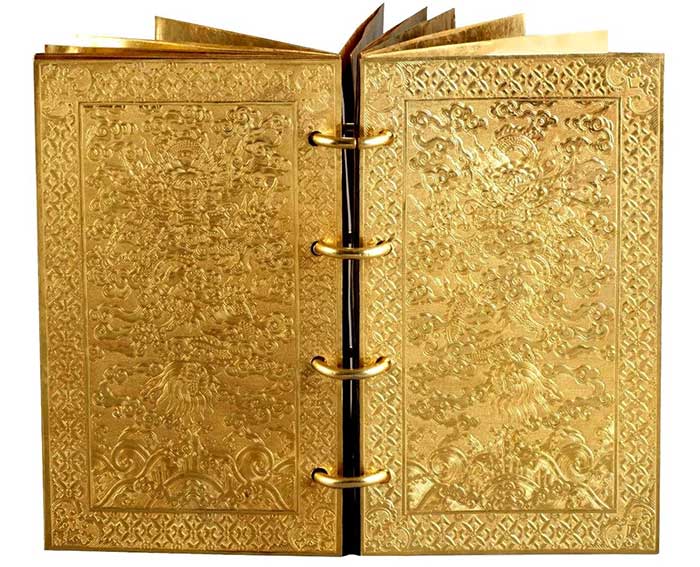
The treasure “Holy Edict Golden Book” issued by Emperor Minh Mang in 1823. (Source: Vietnam Cultural Heritage Department).
It can be said that the Golden Book of Generations holds an exceptionally special value among the 94 golden books of the Nguyen dynasty preserved at the National History Museum. This golden book symbolizes the power of the Nguyen dynasty court, while also serving as an important historical and cultural document linked to the Nguyen dynasty and the history and culture of the Vietnamese nation in the late 19th to early 20th centuries.
The content of the golden book not only reflects the internal affairs of the Nguyen royal family but also clearly expresses the ideological principles in the governance strategies of the Nguyen dynasty, as well as deeply educating the awareness of lineage and the importance of maintaining and strengthening their family line. Furthermore, the Golden Book of Generations is an invaluable national treasure, a distinctive intellectual asset of the Vietnamese nation – a priceless historical document made of pure gold.
Mr. Phan Thanh Hai, Director of the Hue Monuments Conservation Center, affirmed: “Until now, future generations have only known about documents made of paper or silk, while books made of gold and silver are very rare. The golden books and seals are historical and cultural marks, as well as relatively reliable sources that give future generations insight into the lives of kings and the fluctuations of a dynasty.”
Through the ups and downs of history, the hopes of Emperor Minh Mang could not be realized. The throne was only passed down to the 13th emperor, Bao Dai, represented by the character “Vĩnh” – the 5th character in the Golden Generations, marking the end of the last feudal dynasty of Vietnam.
|
(1) Dai Nam Thuc Luc is a chronicle of Vietnam covering the Nguyen Lords and Nguyen dynasty emperors. It consists of 584 volumes, written in classical Chinese, recording historical events up to 1925 (excluding Emperor Bao Dai). (2) According to documents from the Cultural Heritage Department |





















































